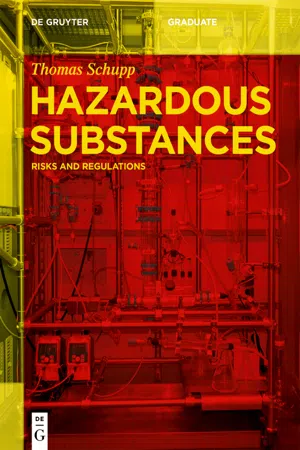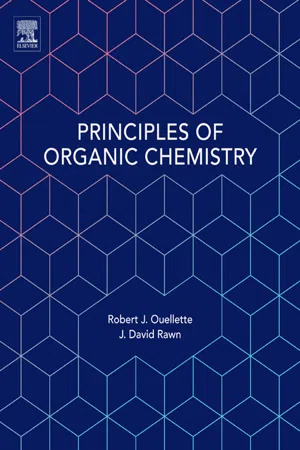Chemistry
Physical Properties of Benzene
Benzene is a colorless, highly flammable liquid with a sweet odor. It has a boiling point of 80.1°C and a melting point of 5.5°C. It is insoluble in water but soluble in organic solvents.
Written by Perlego with AI-assistance
Related key terms
Related key terms
1 of 4
Related key terms
1 of 3
5 Key excerpts on "Physical Properties of Benzene"
- eBook - ePub
- James G. Speight(Author)
- 2019(Publication Date)
- Gulf Professional Publishing(Publisher)
Aromatic hydrocarbon derivatives are derived from benzene. Group members have six free valence electrons which are distributed in a circle in the form of a charged cloud. Because of the presence of these valence electrons, we can predict that the reactivity of these aromatic compounds will be similar to other unsaturated hydrocarbon derivatives. However, benzene is much less reactive than other unsaturated hydrocarbon derivatives. Only at high temperatures and in the presence of a catalyst can benzene take on another hydrogen atom. When it does, cyclohexane is the resultant product.5. Physical properties
Physical properties can be observed or measured without changing the composition of matter. Physical properties are used to observe and describe matter (Howard and Meylan, 1997 ; Yaws, 1999 ). The three states of matter are: solid, liquid, and gas. The melting point and boiling point are related to changes of the state of matter. All matter may exist in any of three physical states of matter. A physical change takes place without any changes in molecular composition. The same element or compound is present before and after the change. The same molecule is present throughout the changes. Physical changes are related to physical properties since some changes require a change in the three-dimensional structure of the molecule.Physical properties that are of interest in the current context include: (i) boiling point, (ii) density and specific gravity, (iii) dew point, (iv) flash point and ignition temperature, (v) melting point, and (vi) vapor density. These properties are listed in alphabetical order rather than attempt to assign importance to any individual property. The properties present indications the behavior of hydrocarbon derives as determined by application of standard test method (Speight, 2015 ).The physical properties of alkene derivatives are similar to those of the alkane derivatives. The boiling points of straight-chain alkenes increase with increasing molar mass, just as with alkanes. For molecules with the same number of carbon atoms and the same general shape, the boiling points usually differ only slightly, just as would be expected for chemicals in which whose molar mass differs by only one to two hydrogen atoms (i.e., RCH2 CHCH2 compared to RCH2 CH2 CH3 - eBook - ePub
- James G. Speight(Author)
- 2010(Publication Date)
- Gulf Professional Publishing(Publisher)
cyclic alkanes) are differentiated from aliphatic hydrocarbons insofar as they contain a ring structure and form a homologous group of compounds. The first member of the series is cyclopentane followed by cyclohexane. Cycloalkanes are saturated compounds and, like linear alkanes, are not very reactive.Aromatic hydrocarbons are derived from benzene. Group members have six free valence electrons which are distributed in a circle in the form of a charged cloud. Because of the presence of these valence electrons, we can predict that the reactivity of these aromatic compounds will be similar to other unsaturated hydrocarbons. However, benzene is much less reactive than other unsaturated hydrocarbons. Only at high temperatures and in the presence of a catalyst can benzene take on another hydrogen atom. When it does, cyclohexane is the resultant product.5. Physical propertiesPhysical properties can be observed or measured without changing the composition of matter. Physical properties are used to observe and describe matter (Howard and Meylan, 1997 and Yaws, 1999 ). The three states of matter are: solid, liquid, and gas. The melting point and boiling point are related to changes of the state of matter. All matter may exist in any of three physical states of matter.A physical change takes place without any changes in molecular composition. The same element or compound is present before and after the change. The same molecule is present throughout the changes. Physical changes are related to physical properties since some measurements require that changes be made.Physical properties that are of interest in the current context include: boiling point, melting point, density, vapor density, flash point, ignition temperature, and dew point.5.1. Boiling points and melting pointsThe boiling point of an organic compound is the temperature at which the vapor pressure of the liquid equals the environmental pressure surrounding the liquid.The melting point - eBook - ePub
- Des W. Connell(Author)
- 2005(Publication Date)
- CRC Press(Publisher)
Part IIBasic Properties of Chemicals in the EnvironmentPassage contains an image
2 Bonds and Molecules: Their Influence on Physical-Chemical Properties in the Environment
2.1 INTRODUCTIONThe behavior of chemicals in the environment is governed by their physical-chemical properties as well as transformation and degradation processes, which are discussed in Chapter 3 . The physical-chemical properties of compounds include such characteristics as boiling point (bp), melting point (mp), solubility in water, and similar properties. These properties are, in fact, measurements made in the laboratory of environmentally relevant characteristics. For example, compounds with low boiling points evaporate rapidly into the atmosphere, whereas compounds that are highly soluble in water disperse readily in streams and rivers. Thus, an understanding of these properties would be expected to give a clearer perception of how compounds will behave in the environment. This means that the measurement of the physical-chemical properties of a compound could be used to provide an evaluation of its environmental distribution in air, water, sediments, soil, and animals.2.2 STATES OF MATTER IN THE ENVIRONMENTA cursory examination of the nature of our environment reveals that matter exists in basically three states: solid, liquid, and gas. Solids are present as soil, rocks, and so on, whereas liquids are represented by the great water bodies of the oceans, lakes, and rivers. The gaseous component of the environment is the atmosphere. These states exercise a basic influence on the nature and distribution of all substances, both natural and man-made, in the environment in basic chemical terms. Solids have a definite volume and shape and consist of large numbers of particles that could be atoms, ions, or molecules (Figure 2.1 - eBook - ePub
Hazardous Substances
Risks and Regulations
- Thomas Schupp(Author)
- 2020(Publication Date)
- De Gruyter(Publisher)
2 Physical and chemical properties of substancesUnderstanding physical and chemical properties of substances is a prerequisite for proper understanding of not only physical–chemical hazards, but also for the understanding of substance behavior in the environment and in organisms.Environmental behavior covers the emission, distribution and fate of a substance in the environment, and this perspective shows similarities to the adsorption, distribution, metabolism and excretion (ADME) of a substance in an organism as discussed in Chapter 3, if an ecosystem (or nature) is regarded as an organism.Physical–chemical properties of substances are part of their identification, and in the field of hazardous substances and risk assessment, proper identification and characterization is crucial for the success of toxicological and environmental investigations. This chapter starts with the identification of substances.2.1 Identification of substances
Identification of a substance starts with simple physical properties that can be checked quickly and without sophisticated equipment. For solids, it is the melting point and visual appearance; for liquids, it is the refraction index, perhaps extended to boiling point, viscosity and density. These methods may provide a hint on purity, already, and it may occur that some limited data on identification are sufficient to check the specification of a product agreed upon between supplier and customer. Nevertheless, a more in-depth check on purity or identification of impurities can be very important. Just as one example: the substance aniline was the parent for the name “aniline-cancer,” describing bladder cancer that was comparatively frequently detectable in workforces in aniline production plants. Later, it turned out that impurities in the technical aniline – namely benzidine and 2-naphthylamine – were the causative agents. To detect and quantify such by-products and impurities, spectrometric and chromatographic methods are required. The European chemicals regulation actually requires the full characterization of a “mono-constituent” substance (see Chapter 8) submitted for registration by UV, IR, NMR and MS spectra, as far as appropriate, and to make use of chromatographic methods [gas chromatography (GC), high-performance liquid chromatography (HPLC) and thin-layer chromatography (TLC)] to identify every component that contributes to at least 0.1% to the technical substance. Lower detection limits may be required if the presence of specific critical impurities cannot be excluded. - eBook - ePub
- Robert J. Ouellette, J. David Rawn(Authors)
- 2015(Publication Date)
- Elsevier(Publisher)
2Properties of Organic Compounds
2.1 Structure and Physical Properties
Each of the millions of organic compounds has unique physical and chemical properties. Thus, we might expect that understanding the relationships between the structure of compounds and their physical properties, such as melting point, boiling point, and solubility, would be a difficult task. Yet we can make reasonable guesses about the physical properties of a compound based on its structure, because organic compounds belong to a small number of classes of substances characterized by their functional groups. These structural units within a molecule are largely responsible for its properties. These properties reflect the attractive intermolecular (between molecules) forces attributable to the functional groups. Intermolecular forces are of three types: dipole-dipole forces, London forces, and hydrogen-bonding forces.Dipole-Dipole Forces
The bonding electrons in polar covalent bonds are not shared equally, and a bond moment results. However, a molecule may be polar or nonpolar depending on its geometry. For example, tetrachloromethane (carbon tetrachloride, CCl4 ) has polar C—Cl bonds, but the tetrahedral arrangement of the four bonds about the central carbon atom causes the individual bond moments to cancel. In contrast, dichloromethane (methylene chloride, CH2 Cl2 ) is a polar molecule with a net polarity away from the partially positive carbon atom toward the partially negative chlorine atoms.Polar molecules have a negative “end” and a positive “end.” They tend to associate because the positive end of one molecule attracts the negative end of another molecule. The physical properties of polar molecules reflect this association. An increased association between molecules decreases their vapor pressure, which in turn results in a higher boiling point, because more energy is required to vaporize the molecules. The molecular weights and molecular shapes of acetone and isobutane are similar (Figure 2.1
Index pages curate the most relevant extracts from our library of academic textbooks. They’ve been created using an in-house natural language model (NLM), each adding context and meaning to key research topics.
Explore more topic indexes
Explore more topic indexes
1 of 6
Explore more topic indexes
1 of 4




